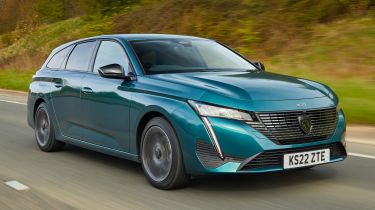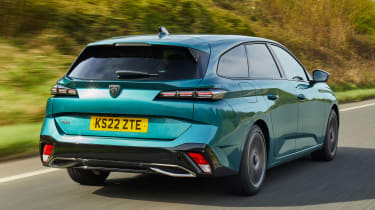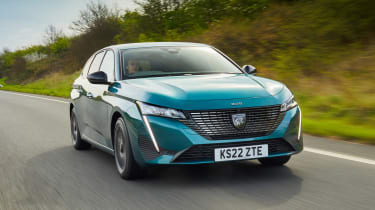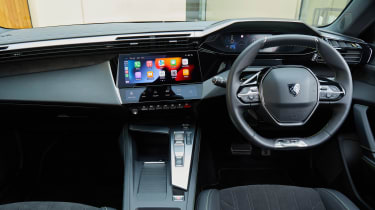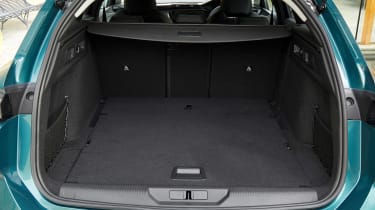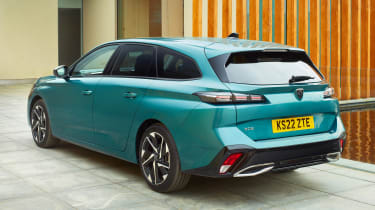Peugeot 308 SW review
The Peugeot 308 SW’s upmarket push brings in plug-in hybrid tech – and higher prices

Is the Peugeot 308 SW a good car?
Estate cars like the Peugeot 308 SW have been a mainstay of the Peugeot line-up for decades, and the latest offers a far sharper and head-turning design than its predecessor. It also comes with a surprisingly premium-feeling interior, which puts some pricier rivals to shame. The 308 SW also differs from some of its competition by being available with a variety of different engine options, including company car driver friendly plug-in hybrid and electric forms to keep Benefit-in-Kind (BiK) costs down.
However, the 308 SW (like its hatchback sibling) doesn’t offer quite as much rear passenger space as some of its rivals, and while it is comfortable for the most part, it doesn’t drive with the same degree of polish as Ford Focus Estate, and the eight-speed automatic fitted to petrol and diesel versions isn’t very smooth. There are also a few estates, such as the Skoda Octavia Estate, that offer a bigger load area, which is the main reason you’d choose this type of car.
|
Key specs | |
|
Fuel type |
Petrol, diesel, hybrid, electric |
|
Body style |
Compact estate |
|
Powertrain |
1.2-litre 3cyl turbo petrol 1.2-litre 3cyl turbo petrol/mild hybrid 1.5-litre 4cyl turbo diesel 1.6-litre 4cyl turbo petrol + e-motor 54kWh battery, 1x 154bhp e-motor |
|
Safety |
Four stars Euro NCAP (2022) |
|
Warranty |
3yrs/60,000 miles 8yrs/100,000 miles (battery only) |
How much does the Peugeot 308 SW cost?
Now in its third generation, the current Peugeot 308 SW starts at just under £30,000 for the Active trim, with the mid-range Allure adding a further £1,500 to that. The sporty-looking, range-topping GT comes in at around £34,000, and stops just shy of £42,000 for the electric version.
Used - available now
Much like its five-door hatchback sibling, SW estate is based on the EMP2 platform that also underpins rivals such as the Vauxhall Astra.
Over the years, Peugeot rationalised the 308 SW lineup, so now there are just three trim levels: Active, Allure and GT. Depending on the model and trim, there’s a choice of powertrains, including a turbocharged 1.2-litre petrol in standard and mild hybrid guises, a frugal diesel, a pair of plug-in hybrids and, unusually for a compact estate, an EV option.
The level of standard equipment for the entry-level Active trim is reasonably generous, with 16-inch alloy wheels, automatic headlights and wipers, auto air-conditioning, rear parking sensors and Peugeot’s i-Cockpit twin-screen set-up that covers driver information and infotainment systems.
Upgrading to Allure specification adds 17-inch alloy wheels, dark tinted side glass, a reversing camera and extra driver modes. It also brings the brand’s i-Toggle set-up that allows you to customise the infotainment’s shortcuts with your most commonly used functions.
At the top of the range is the sporty look GT gets 18-inch alloys, matrix LED headlamps, ambient interior lighting, adaptive cruise control and a 3D instrument cluster.
Engines, performance & drive
Peugeot’s reputation for delivering cars that are great to drive has taken a hit in recent years. The French firm’s back catalogue, from superminis to big saloons, was brimming with machines that served up fine handling and a cushioned ride, but its latest run of contenders has been rather average. Happily, while the 308 SW isn’t exactly a return to form, it is a capable and composed choice that isn’t as far behind the class leaders as you’d think.
The turbocharged 1.2-litre PureTech three-cylinder petrol is the entry-level unit and delivers 129bhp. It’s reasonably smooth and responsive, and with a 0-62mph time of 9.7 seconds, it offers respectable enough performance.
Recently added to the range is a novel HYBRID 136 e-DSC6 mild hybrid that attaches a 28bhp electric motor and six-speed dual-clutch gearbox to the existing 1.2-litre petrol. With 134bhp, it has a little more power than the standard petrol, but its 270Nm torque output is identical. It can drive for very short periods in EV mode, and when both the petrol engine and electric motor work together, it’ll crack 0-62mph in 9.3 seconds. In day-to-day use, however, it feels very similar to the non-hybrid model.
Next is the 1.5-litre BlueHDi diesel, which offers the same power with 300 Nm of torque. It’s around a second slower than the petrol in the benchmark acceleration test, but with much more mid-range muscle, the refined four-cylinder unit feels brisker in the real world.
If you’re looking for extra pace, then the plug-in hybrid model offers an extra injection of urge. The 178bhp version manages the 0-62mph sprint in 7.6 seconds, while the extra £1,400 needed for the 222bhp PHEV (it’s only available in GT trim) buys just an extra tenth of a second.
Yet while both offer greater on-paper performance potential, the powertrain integration lacks a little sophistication, with the occasional interruption in delivery as the computers shuffle between unleaded and electrical assistance. On the plus side, both plug-in hybrids have a large enough battery to travel up to 40 miles on electric power alone, and can get up to motorway speeds without needing the engine.
One gripe we have is with the French hatchback’s eight-speed automatic transmission, which is used in the standard petrol and diesel models. There’s no manual alternative, which is a shame because it feels quite awkward at times – not quick enough to pick up when attempting to pull away from a junction, and it takes too much time to re-engage a gear at the end of a low-speed coast. The rest of the time, it’s smooth enough, helping to make the Peugeot a fuss-free choice.
Finally, there’s the recently revealed all-electric Peugeot E-308 SW. Performance is brisk rather than rapid, for as with other Stellantis models, the more powerful motor won’t provide the full 154bhp unless you engage its Sport driving mode. In normal mode, power is lowered to 134bhp in order to boost efficiency and, therefore, preserve range. Even in Sport mode, there’s a slight delay between standing on the throttle pedal and the system delivering that traditional EV shove. It’s far from a deal breaker, but it does mean that, even in its most potent configuration, the powertrain responds better to a smooth approach than genuine commitment.
Regardless of the powertrain, you sit quite low in the car; if you’re on the short side, you’ll need to raise the seat high with the steering wheel position set low just to be able to get a decent view of the i-Cockpit digital dials, which all feels a little odd. Still, it’s comfortable enough, and the cabin is impressively insulated from road and wind noise.
On the move, the 308 is fairly nimble in and around town, with its quick steering providing good feel and precision, although the small, stylish-looking wheel won’t be to everyone’s tastes. Both the driver and passengers will find the ride perfectly comfortable, though, with the 308 SW’s suspension set-up adequately able to smooth out any bumps in the road.
On faster roads, the 308 SW flows with a pleasing poise and neutrality thanks to decent grip, while body movements are fairly well-contained. Rivals such as the Ford Focus Estate are more engaging and agile, but the Peugeot does have more than a hint of the nimble responses and supple ride that used to be a calling card of its famed family cars of the Eighties and Nineties.
|
Model |
Power |
0-62mph |
Top speed |
|
Peugeot 308 SW BlueHDi 130 Active |
128bhp |
10.9 secs |
120mph |
|
Peugeot 308 SW PLUG-IN HYBRID GT 225 |
222bhp |
7.6 secs |
146mph |
|
Peugeot E-308 SW Allure |
154bhp |
9.9 secs |
109mph |
MPG, emissions & running costs
A petrol-engined 308 SW should average around 43.3mpg (under the current WLTP testing procedure), although this could be as high as 51.9mpg if you go for a version with smaller wheels and less kit.
Opting for diesel power brings obvious improvements to fuel economy – the 1.5-litre BlueHDi unit fitted to the 308 SW claims between 50.1-59.6mpg on the WLTP combined cycle. During our own testing of the 308 SW diesel, we saw an average of 54.1mpg.
However, the fuel efficiency honours go to the hybrid, which claims between 48.5 and 62.6mpg, depending on the specification. This version is particularly frugal at lower speeds, where the electric motor can take some of the strain in stop-start traffic.
Better still, the hybrid’s CO2 emissions are as low as 107g/km, which means it falls into the 26% band for Benefit-in-Kind company car tax. By contrast, the petrol and diesel versions are rated at anything between 123-148g/km, meaning their users are taxed at a rate of between 30-31 per cent.
The 308 plug-in hybrid models offer wider appeal, firstly with the ability to run on electric power alone for around 40 miles and also by producing far lower CO2 levels (23-25g/km). This means BiK rates start from just 12 per cent. It’s important to remember, though, that the PHEV versions are significantly more expensive to buy than their fossil-fuelled siblings.
Finally, with its 54kWh (51.5kWh usable) battery, the E-308 SW claims up to 254 miles on a charge – although in real-world use, you can expect closer to 220 miles in ideal conditions. Three-phase charging comes as standard – although 11kW compatibility is more useful in continental Europe than the UK – and 100kW DC charging can take the E-308 SW from 20 to 80 per cent of its charge in less than 25 minutes.
For business users, the electric E-308 SW makes the most sense, provided its range and recharging speed fit in with their daily duties. Attracting just 2% in BiK, it’ll save even lower rate taxpayers thousands of pounds from their annual salary sacrifice.
Insurance costs for the petrol, hybrid and diesel-powered 308 SW should be fairly reasonable. Most versions fall into insurance group 19, with the GT and GT Premium cars in either group 20 or 21. Next up is the E-308 SW, which offsets its low tax and recharging bills with slightly higher groupings of 24 for the Allure and 25 for the GT.
Premiums are likely to get a little more expensive if you plump for the 177bhp plug-in hybrid, which starts from group 26. The 222bhp PHEV is higher again, with the GT version (the only trim level available with this powertrain) falling into group 30.
The latest 308 SW is predicted to retain between 43 to 47 per cent of its value over three years and 36,000 miles, according to our expert data. The best-performing model is the 1.2 PureTech GT model, while the plug-in hybrid 1.6 180 Allure is expected to lose the most.
|
Model |
MPG |
CO2 |
Insurance group |
|
Peugeot 308 SW PureTech 130 Active |
43.3-51.9 |
123-147g/km |
19 |
|
Peugeot 308 SW PLUG-IN HYBRID Allure 180 |
199.4-242.7 |
26-32g/km |
19 |
|
Peugeot 308 HYBRID 136 eDSC6 |
48.5-62.6 |
102-131g/km |
28 |
Design, interior & technology
The latest version of the 308 SW sits on a revised version of the familiar EMP2 platform, which allows for petrol, diesel, plug-in hybrid and electric powertrains. It was developed prior to Peugeot’s absorption into the Stellantis group and forms the basic architecture that underpins its Vauxhall Astra and DS 4 stablemates, as well as the brand's larger Peugeot 3008 model.
From the outside, Peugeot’s distinctive compact estate certainly catches the eye. With a rakish front design and sharp creases along the shoulder line, it’s definitely a bit of a head-turner. The conversion into an estate car has been well executed, with the 308 SW’s longer rear overhang and upright tail having been neatly grafted on. The 308 SW is available in some eye-catching exterior colour schemes, such as the free Avatar Blue, or Elixir Red for a pricey £950.
Things get even better once you’re sitting inside, where it's clear Peugeot has spent a lot of time improving overall quality. It feels like a genuine challenger to premium models and easily outclasses the Volkswagen Golf, which wouldn’t have been the case just a few years ago. Not only is the interior crisply designed, but it oozes premium appeal with its solid build and careful use of high-grade materials.
Peugeot’s trademark i-Cockpit system is standard on all models, but takes a bit of getting used to. It incorporates a 10-inch media touchscreen and a digital driver’s display of the same size, and works well enough. However, the small steering wheel design means you have to peer over the top to be able to see the dials, rather than looking straight through. It’s an unusual arrangement, and we’d advise having a decent test drive to see whether it feels right for you.
Moreover, we’re not sure the optional 3D instrument is anything more than a gimmick. It’s standard on the GT, and projects information onto an extra screen that ‘floats’ on top of the regular info. It smacks of two elements trying to do a job that a single, less fussy interface could manage by itself.
Sat-nav, stereo and infotainment
The 308 and 308 SW were the first models to benefit from Peugeot’s updated infotainment set-up. While it’s an improvement over the systems in previous models, it’s still not without flaws.
On the plus side, the 10-inch screen itself is excellent, with a high resolution that delivers graphics that are crisp and clear – the rear-view camera delivers a truly high-definition image. There’s also Bluetooth connectivity and a pair of USB ports, including one USB-C connection.
Allure models and above feature Apple CarPlay and Android Auto smartphone connectivity, as well as the brand’s i-Toggle technology. This comprises physical shortcut buttons on the dashboard, positioned beneath a smaller touch panel where you’re able to place widgets or shortcuts to commonly requested features, such as heating or ventilation.
It’s still not quite as good as having a regular switch or dial for temperature and fan speed, but it’s a move back in the right direction compared with Peugeot’s recent efforts in this area. The interface on the screen itself is clear enough, although we’d suggest the animated transitions between screens are there to disguise lag; they certainly don’t enhance usability.
Boot space, comfort & practicality
Measuring 4,635 mm from bumper-to-bumper, the 308 SW sits between the Ford Focus Estate (4,668mm) and Volkswagen Golf Estate (4,631mm) in terms of overall length, but its 2,735mm wheelbase is actually the longest of the three. At 1,475mm high, the French machine is actually one of the sleeker load luggers.
However, that sleek design does compromise practicality for those in the back. Just getting in is more of a struggle than in the Skoda Octavia Estate because the door opening in the 308 SW isn’t that wide. There’s around 16mm more headroom in the back of the SW when compared with its hatchback counterpart, but it’s a shame that long wheelbase hasn’t translated into an extensive amount of rear leg room. If there’s a taller driver up front, legroom in the back is only suitable to smaller rear passengers, and there’s a sizeable transmission tunnel that makes it awkward when you need to sit three across the rear bench.
Up front, the driver and passenger are well catered for thanks to supportive seats that offer a wide range of adjustment. The steering wheel position can be fine-tuned for rake and reach, but as with all Peugeot models fitted with the i-Cockpit layout, finding a comfortable driving position where you can see all the dials takes a bit of time.
You’ll also find plenty of handy storage dotted around the cabin, making the 308 SW a family-friendly choice. There are numerous cup-holders and cubbies, plus some large door bins and a large armrest between the front seats that opens to reveal a decently-sized compartment.
At up to 608 litres for the petrol model, luggage space behind the rear seats is certainly impressive. It's also worth noting that the more versatile 40:20:40 split rear seats are fitted from the Allure trim upwards.
Pick an electric or plug-in hybrid version, and the boot shrinks to 548 litres. The reason for raising the floor is in order to accommodate the battery pack. We would have liked to have seen space made to stow the charging cables, because they have to travel in a bad in the boot, which takes up valuable space.
Fold the rear bench flat (using handy levers in the boot) and you’ll have access to a generous 1,634 litres of capacity in the petrol models, while the electric and PHEV make do with a smaller 1,574-litre load bay. Either way, there’s a low lip, making it easy to lug heavy items into and out of the boot, while the load space itself is well-shaped with minimal instructions.
If you’re thinking of putting your 308 SW to use as a towing vehicle, you’d be better off with the BlueHDi diesel model which is rated at 1,550kg in terms of braked trailer towing capacity. The plug-in hybrid models are almost as capable, being able to tow up to 1,500kg. Like many EVs, the E-308 SW isn’t rated for towing.
|
Dimensions | |
|
Length |
4,635mm |
|
Width |
1,850mm |
|
Height |
1,475mm |
|
Number of seats |
5 |
|
Boot space |
608-1,634-litres (petrol & diesel), 548-1574-litres (EV & PHEV) |
Safety & reliability
Peugeot also has a strong track record of five-star safety ratings when its cars are crash-tested, but when Euro NCAP tested the closely related 308 hatchback it managed only a four-star score. Arguably, the downgraded rating has little to do with the Peugeots performance in a crash, but is more a reflection that some of its safety technology is an extra cost option.
Standard driver aids include lane keep assist, driver attention alerts and speed limit warnings, but you’ll need to upgrade to Peugeot's Drive Assist Pack to get blind-spot monitoring, adaptive cruise control and rear-cross traffic alerts to help prevent collisions while reversing.
Neither the 308 SW estate or its hatchback sibling featured in our Driver Power customer satisfaction survey in 2024, but the Peugeot brand did, coming in an impressive sixth place out of 32 brands.
Contrary to old stereotypes about French cars, only 20.8% of owners reporting an issue with their car in the first year – that’s a lower than average figure, but still not quite as good as brands like Toyota or Honda, which scored just 18.1% and 13.8%, respectively. One of the lowest-rated categories for Peugeot, despite high scores across the board, is its infotainment, which owners don’t seem to consider very user-friendly.
The 308 is covered by a three-year warranty, with unlimited mileage for the first two years and a 60,000-mile limit applied to the third year. For the E-308 SW, there’s a separate eight-year or 100,000-mile guarantee for the battery – although this can be extended to cover the rest of the car for the same period.
Peugeot Service Plans cover scheduled maintenance costs for up to five years, with various mileage options. You can pay on a monthly basis, although the plug-in hybrid models cost a little more than the regular petrol or diesel versions.
|
Key standard safety features |
Euro NCAP safety ratings |
|
|
Peugeot 308 SW alternatives
Competition in the compact family estate car market remains, with mainstream perennials such as the Ford Focus, Vauxhall Astra and SEAT Leon Estate all offering equally capable and spacious load luggers. There’s also the stylish Kia Ceed Sportswagon which lacks some of the space but counters that with a lengthy warranty. Speaking of a long warranty, you could also consider the Toyota Corolla Touring Sports, which also has a very efficient hybrid system that provides a fine middle ground for those who need more efficiency than a petrol can manage, but don’t have easy access to a charging socket to make a plug-in hybrid or electric car work.
If space is a priority (and you’re looking for an estate, so why wouldn’t it be?), then it’s hard to look past the Skoda Superb Estate. The latest version not only looks smart and boasts an upmarket vibe, it has one of the biggest boots in the business.
Where the Peugeot 308 SW steals a march on rivals is offering an all-electric drivetrain option. In fact, the only other current rivals are the mechanically identical Vauxhall Astra Sports Tourer Electric and the dull but worthy electric MG5.
Frequently Asked Questions
While the Peugeot 308 SW didn’t feature in our latest Driver Power survey, owners did place the brand in sixth place overall, suggesting strong satisfaction.
More reviews
Car group tests
In-depth reviews
Long-term tests
Which Is Best
Most Economical
- Name1.6 Plug-in Hybrid 195 Allure 5dr e-DSC7
- Gearbox typeSemi-auto
- RRP£39,310
